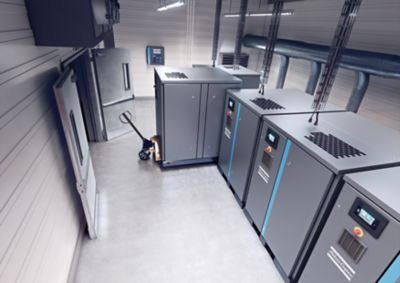What are compressor transient losses and why do they matter?
Efficiency matters: compressor transient losses explained
There are 3 types of rotary screw compressors: fixed-speed, dual-speed, and variable speed drive (VSD). Compressor transient losses help explain the vast difference in energy efficiency between these 3 types.
What are compressor transient losses?
The term transient losses refers to the energy that a compressor consumes without producing usable air as it cycles between operational phases. It is a term that reflects energy waste. For a traditional fixed-speed compressor, these losses can add up to 20% of its total energy use. Dual-speed screw compressors experience only minimal transient losses. Variable Speed Drive compressors eliminate them almost entirely.
What are transient losses?
Transient losses in fixed-speed vs dual-speed compressors
In this article we will look at the 2 compressor types for which transient losses are a factor: fixed-speed and dual-speed compressors. We will also explain why fixed-speed compressors can never meaningfully reduce transient losses, no matter how efficient they are. And we will show how dual-speed do succeed in significantly lowering this wasted energy.
Transient losses in fixed-speed compressors
Transient losses are inherent to fixed-speed compressors. That's because they can only operate at 100% motor speed and because they cannot start against a system under pressure.
Here’s why:
At start-up: When the motor starts, the air/oil separator vessel must first fill up. Only when the compressor reaches a pressure of 4 bar, the minimum pressure valve opens and it starts supplying compressed air. Until that moment, all energy used to start the machine falls under transient losses.
Full load: When demand is at its maximum, the compressor runs at optimal efficiency. No wasted energy here.
Lower air demand: When demand lowers, a fixed-speed compressor goes into unload. This is when the motor runs at maximum speed without producing any air, a pure waste of energy. However, in the transition from load to unload, a fixed-speed compressor experiences additional transient losses. As the inlet closes, the air/oil separator vents to 1/2 bar. That’s because the compressor cannot start up again later while still pressurized. The term blow-off losses refers to the energy needed to produce this vented air.
Shut-off and restart: When demand continues to stay low, a fixed-speed compressor will eventually shut off. When air flow picks up, the compressor must reboot, starting the transient loss loop all over again as well.
Transient losses in dual-speed compressors
A dual-speed compressor reduces transient losses by double digits compared to fixed-speed units. That’s because it operates at a minimal speed during unload and because it can start against a system under pressure.
Here's how it works:
At start-up: Beginning with a completely empty compressor, a dual-speed compressor starts up much like a fixed-speed compressor.
Full load: When demand hits its peak, the compressor runs at its maximum speed. No wasted energy, but also no real wins compared to a fixed-speed compressor.
Lower air demand: When demand lowers, a dual-speed compressor also goes into unload. But while in unload, it runs at a minimum speed to significantly reduce energy waste. In addition, because a dual-speed unit can start under pressure, it minimizes blow-off losses as well.
Shut-off and restart: A dual-speed compressor can start under pressure. This means it can reboot up faster and it requires less energy to do so than a fixed-speed compressor.
The cost of compressor transient losses
This article explained the concept of compressor transient losses, why fixed-speed compressors experience them, and how dual-speed compressors reduce them. Because energy costs typically constitute 80% of the total cost of a compressor, this difference in efficiency has a big impact on operational costs.

